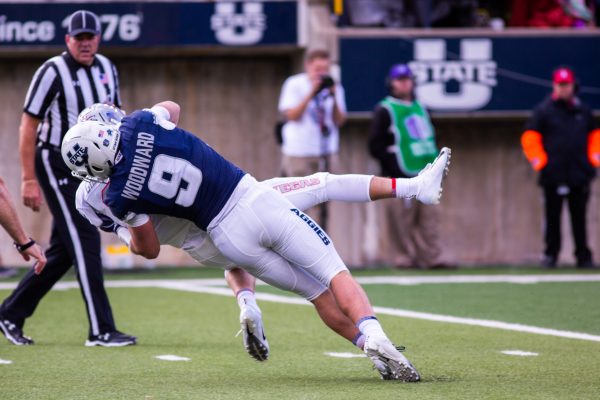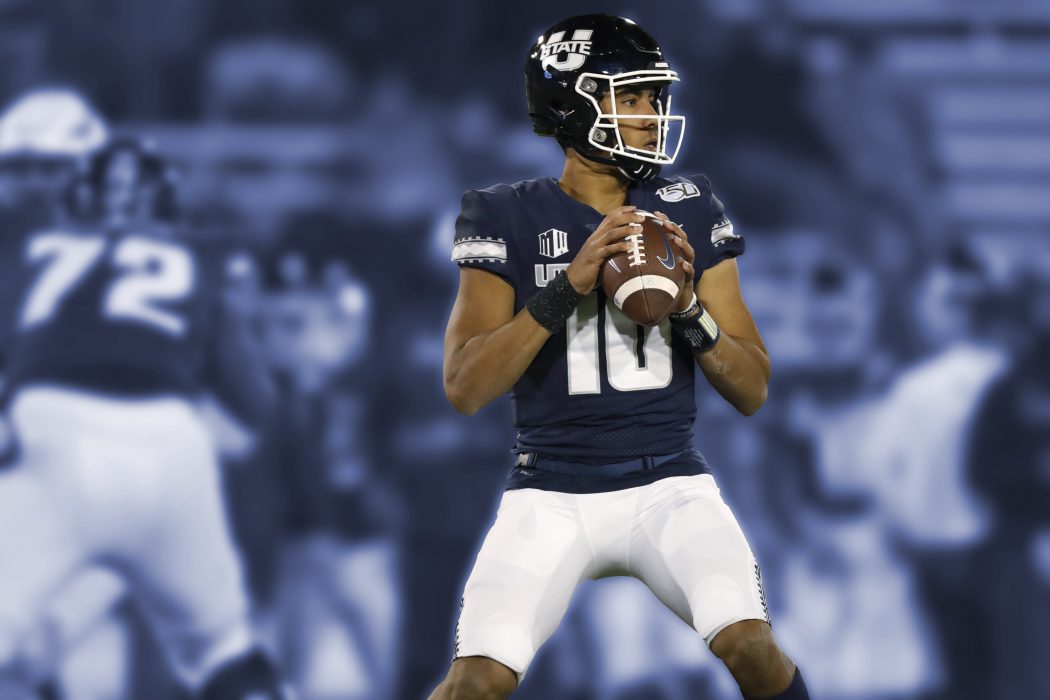Love, Woodward headline USU NFL Draft hopefuls
Normally, the NFL draft is an event most Utah State fans are able to ignore as the school hasn’t exactly been known as a factory for NFL players since the 1960s Aggie golden era. This year, however, Aggie fans have a little more investment in seeing the results — namely in former USU quarterback Jordan Love and inside linebacker David Woodward. These two, especially Love, are among the better NFL prospects Utah State has produced in a decade. This makes their fate on draft-day a popular topic of discussion.
And despite the sports world coming to a grinding halt in the face of the COVID-19 onslaught, the NFL will still hold its annual draft, albeit without the live crowd and arena spectacle everyone has come to know so well.
While Aggies clearly hold Love — the program’s all-time leader in total offense among 10 other career and single-season records — in very high regard, the NFL world can’t seem to make up its mind on him, something that has cast Love’s draft stock into the realm of mystery.
On the one hand, no scout can deny the arm talent the young Californian displayed in his 32 starts across three seasons for the Aggies. One of Love’s record-setting marks, four career touchdown passes of 80-plus yards, is a mere symptom of his ability. It’s largely why many have been bold enough to compare his stock to the 2018 NFL MVP, and reigning Super Bowl MVP, Patrick Mahomes. Love, himself, offered that comparison on the basis of arm talent.
Using his gifted arm, Love set five of his single-season school records including 3,567 passing yards and 32 passing touchdowns in 2018. His low interception total, just six, and 64.0 completion percentage solidified that year as the best-ever for a quarterback in Utah State history, and it caught the eye of scouts.
However, Love’s 2019 numbers forced every scout who drooled over his 2018 performance to hit the pause button.
After throwing just 12 career picks between 2017 and 2018, Love tossed 17 passes that ended up in the hands of his opponents in 2019 alone, the most among all Football Bowl Subdivision (FBS) quarterbacks. Love had games of three-plus picks three times. These interceptions weren’t just a collection of poor luck or bad bounces. The vast majority of these turnovers could be boiled down to baffling decisions or poor reads from Love.
To no one’s surprise, Love was asked by teams at the NFL Scouting Combine about throwing more interceptions last year than any of his collegiate peers.
“I threw 17 interceptions — obviously I’m going to have to talk about them,” Love said. “It’s never fun, but if I don’t want to have to talk about it, I don’t have to throw 17 interceptions.”
If one looks closely enough at the 2018 tape, and even further back into 2017, the evidence of Love’s interception-prone nature is buried beneath the facade of weaker schedules and better receivers. But these frustratingly numerous bad plays from Love throughout all three of his seasons are sandwiched between gobs of highlight-worthy throws that would make several NFL starters turn red with jealousy.
According to ESPN, former USU head coach Matt Wells, who coached Love during his record-book altering 2018 campaign, has received calls from no less than seven NFL head coaches over the last five days wanting to figure out just who Love is. Is he the football savant, destined to be capable of Hall of Fame-level throws, or is he bound for the bargain bin of long-armed quarterbacks?
Coaches, scouts and GMs seem desperate to know as none want the shame of passing on an All-Pro quarterback or the equal ignominy of reaching for an over-hyped bust.
As it stands, most believe Love will not fall out of the first round, while others are convinced he can — and should — go inside the top 10. It’s a wide gap for Love to be placed in, but the volatility of the draft makes it impossible to predict accurately if Love will be the first top 10 pick from USU in 50 years or “just” a mid-to-late first round pick.

Photo by Tim Carpenter
Woodward will enter the draft having not played football for 180 days as he missed the final six games of Utah State’s season. Had the Washington native not missed those games, he could very well have achieved 180 tackles this season, as Woodward was on pace for 172. Since 2000, only five players have eclipsed 170 tackles in a season. As it stands, he ended the season with 93 tackles to his name through seven games.
Aside from his boggling tackle totals, a big part of what may entice a team to Woodward as a prospect is the growing number of Aggie linebackers to have entered the professional ranks. Three former USU linebackers have been drafted in the first three rounds since 2012 — Bobby Wagner, Kyler Fackrell and Nick Vigil — and all three have proven valuable to their squads. Wagner led the NFL in tackles in 2019 with the Seattle Seahawks. Vigil also topped 100 total tackles, posting a career-high 111 with the Cincinnati Bengals, and while Fackrell’s statistics didn’t pop off the sheet for 2019, he led the Green Bay Packers in sacks in 2018 with 10.5 — nearly double the next-closest Packer.
This USU pedigree of linebackers could become a deciding factor for a GM considering taking a chance on Woodward despite him performing poorly in NFL Combine metrics, coming from a smaller school and having an injury history that raises red flags regarding long-term health.
The final three former Aggies with any serious chance of hearing their names on draft weekend are tight end Caleb Repp, edge rusher Tipa Galeai and kicker Dominik Eberle. As of now, each has their own attractive aspects but also glaring flaws when it comes to transitioning to the NFL.
According to NFL.com’s pre-draft ratings, Repp is actually the second-best prospect out of USU despite appearing on virtually no draft boards. Repp started just one of his collegiate years as a tight end, but he’s got a solid modern pass-catching record going for him. His hands and body control are good, and his resume includes multiple highlight-reel catches. The primary drawback for the former Aggie is he currently has a very slight build unbecoming of most professional tight ends and the previously mentioned lack of experience at tight end.
Galeai’s situation is eerily similar to Repp’s, being a talented and athletic specimen but lacking the typical size found among NFL defensive ends. It’s not a lack of height, or even reach, as Galeai boasts a well-above average 6-foot-5 frame with long arms. Rather, the mere 235 pounds found on that frame, when his NFL contemporaries range from 30 to 70 pounds heavier, is what has teams worried about Galeai’s ability to transfer his talents to the pro level. At the very least, it puts a ceiling on Galeai’s chances of making an immediate impact on the next level.
As far as Eberle goes, most people, even Aggie fans, would assume that despite being the best kicker in Utah State history, being drafted was always a long shot. Since 2000, only 43 kickers have been drafted, an average of just over two per season, and only a mere four of those kickers were taken before Day 3. The assumed path for Eberle will be to sign on with a team and win a job in training camp.
Despite a solid record of making 50-plus yard field goals, NFL scouts don’t seem overly impressed by Eberle’s leg and are underwhelmed by his kickoff skills, which do show inconsistency and poor hang time. The main draw for Eberle is his ability to hit just about anything within 50 yards — a valuable skill in the NFL. Very few teams are dead-set on their current kicker, so there are plenty of openings for Eberle to try and slip through as long as he’s able to capitalize on any of those chances.
@thejwalk67
— jasonswalker94@gmail.com

